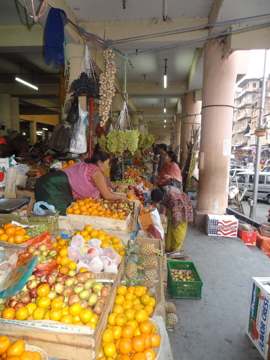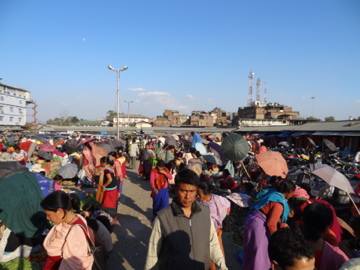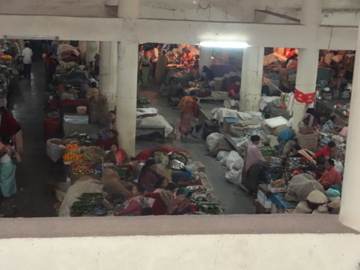

Ima Market is a noteworthy fixture in the city of Imphal. Located mere meters from Kangla Palace, the most noteworthy historical site in the city, it’s the hub of basically all commodity trade in Manipur. Walking or driving toward it is actually fairly difficult, as it attracts so many customers that the area surrounding it becomes congested at any time of day with rickshaws, autorickshaws, cars, mopeds, and pedestrians all competing for road space.
The marketplace is lauded as the largest all-women’s market in Asia. One article I found about the market actually claims it is the only exclusively women-run market in the world. Several Google searches, however, could not confirm nor deny either of these claims, so for the sake of this blog post I’ll take them both as true. I can definitely see how this could be so; you take one look at the place and are immediately impressed and awestruck.
The market is comprised of three buildings that look like this:
One is just for fruits and vegetables and two are for mostly woven products and jewelry. Beyond these covered market buildings, the fruit and vegetable vendors also sprawl out on an open floorspace outside.

I’m told that there are over 3,000 women vendors registered to sell at this market. It seems that the rules for becoming a vendor are somewhat lax. At home in California, for example, in order to register as a vendor in my community’s famers markets the farmers have to prove that they grow their produce themselves (or make their goods themselves). Here, it seems as though many vendors actually buy their produce or products from someone else and then sell it at the market at a slightly higher price. If one were to visit the market early in the morning, before it officially opens at 9 AM, they’d find women buying and selling goods in bulk to other vendors at a discounted price.
I’ve spent quite some time roaming the aisles and outdoor areas of Ima Market; I’m a big proponent and admirer of farmers markets back in the U.S. so walking around in Ima feels a little like home. It’s also a huge comfort to see the amazing variety of fruits and vegetables found here. We’ve got everything from eggs to eggplant, apples to pineapple; you can find something like 4 different varieties of what we would call English peas, 6 varieties of what we know as green onion, and at least three kinds of bananas (my personal favorite are the small apple bananas – you know, the short and very sweet ones you usually find in the tropics).
 "Aerial view" of one of the market buildings
"Aerial view" of one of the market buildingsPricing is pretty uniform around the market, although you’ll find that the vendors located inside the covered market area have to charge slightly more (or sell more expensive produce) since they have to pay to rent their stall spaces. I’ll tell a personal story to give you some examples.
I always, always buy tangerines. Ever since I was a child, tangerines have been a staple fruit thanks to my mom’s insistent quest for her children’s health. I’m not sure whether it’s out of habit or taste that I continue to buy them, but either way it’s almost a guarantee that I’ll have tangerines in my kitchen throughout the duration of their season.
First of all, I was relieved to find that tangerines are plentiful at Ima Market. They tell me it’s one of the only fruits in season right now. As I peruse the stalls inside the covered market building, the vendors all trying to get me to buy their produce by calling me beautiful (I accredit this to the fact that they don’t see many --- really any – foreigners here), I stop along the way to ask prices of tangerines. Woman after woman tells me “100 per kg”. I continue on my way, telling them that’s too expensive for me.
To give you a frame of reference for pricing, Rs.100 is about 2 USD right now. Compared to other edible goods, I’ll just say this: a loaf of sliced bread costs Rs.10 and a cup of tea at a tea stall costs Rs.5 or Rs.10 depending on its location.
As I continue my journey outside, the pricing begins to change. I start hearing “90 per kg” and then finally “80 per kg.” This is where I stop to buy.
The pricing is actually much more complicated than differentiation by market real estate. Manipur is plagued by pretty frequent “bandhs” or protests instated by insurgent groups throughout the state. These groups are all after different things, but the root of most of them is that these groups want independence from India. Some insurgent groups want independent states for their respective tribes. Some groups simply want money. The tactic by which to achieve these goals is by instating bandhs; they block the roads in and out of Imphal, isolating the city from the surrounding areas.
During a bandh, commodity prices escalate. Charcoal, cooking and vehicle gas can cost up to 50% more than usual. Fruits and vegetables are not immune to these price increases either, because most of the produce for sale in Imphal comes from surrounding villages.
Last week, there was a bandh by one of the more powerful insurgent groups. Luckily, it only lasted three days, but from what I am told the last bandh this group imposed lasted three months. In three days alone, the prices of tangerines, to return to my oh-so-useful example went up to Rs.140 per kg. Not all bandhs have this effect, as not all groups can successfully block all the roads into and out of the city; some simply don’t have the manpower or weaponry to hold their ground.
Given this knowledge, I’ve found it particularly useful to go to the market with someone who is actually from Imphal. First of all, I did not know Rs.100 was too much to pay for a kilogram of tangerines. I also did not understand why one day the price was Rs.140. I thought that perhaps they were of a better quality, and I was actually tempted to buy them assuming they’d be sweeter. Turns out, there’s very little difference in quality of produce found in Ima Market. The distinctions you can draw, however, are between local and non-local produce, as well as organic and non-organic products. The issue is that there is no surefire way to know “what’s what.” Asking gets you nowhere; if you ask if something is local the answer is “yes” and if you ask if something is organic the answer is “of course,” sometimes followed with an “I grow it in my yard.” These women know the answers buyers are looking for, and aren’t afraid to lie to make a sale. I’ve even been told that women who sell eggs use tea to dye their farmed eggs the color of the local eggs, trying to pass them off as local eggs for more money.
I’ve picked up another useful tip for determining whether a product is organic; they say if it’s ugly it’s organic, if it’s pretty, it’s not organic. I have been employing this method. Unfortunately, there’s really no way to tell whether something is organic while you’re preparing or consuming it, so I will just choose to believe everything I’ve purchased is organic to appease my Californian attitude.
Beyond that, it has been suggested that I get to know certain vendors. I’ve been introduced to one woman who is from one of the villages in which WSDS works, so now I can buy certain products from her, knowing they are local and organic. It turns out there are two Kiva clients who sell at the market as well, and in my next installment about Ima Market I will introduce you to them. I’ll also introduce you to the Secretary of the market, who has a truly inspirational opinion about what purposes the market serves beyond its practical use of buying and selling.
For now you can all rest assured that I will continue, with assurance, to buy organic/non-organic local/non-local produce from the largest and/or only exclusively women-run marketplace in Asia and/or the world.
PREVIOUS ARTICLE
A Fellow, A Taxi, A Loan, A Vision →NEXT ARTICLE
Passport Series: Kiva partners make great strides in Lebanon →













